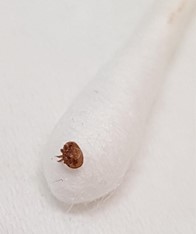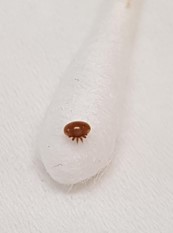Report suspected varroa mite
Varroa mite (Varroa destructor) is notifiable under the Queensland varroa mite biosecurity zone. V. destructor was delisted as prohibited matter under the Biosecurity Regulation 2016, as it no longer met the definition under the Biosecurity Act 2014.
Help slow the spread of varroa mite in Queensland by:
- monitoring hives every month
- reporting hive checks using the Bee 123 form
- coming clean and going clean, especially between apiaries.
Step 1: Take a photo of the suspected mite
The best photo of suspected varroa mite includes:
- the mite against a white background
- clear view of the specimen, separated from other material
- specimen laying right-side-up (legs down) or upside-down (legs up)—as long as the shape of the mite is clearly visible
- something in the photos for size comparison (e.g. cotton bud, coin or pencil).
Placing the mite on the tip of a cotton bud is the preferred method.
If you cannot separate the suspected varroa mite from the bee or pupae, take a photograph with the mite still on the bee or pupae. The mite must remain in clear view.
If you are unable to take a photo, contact us online, by phone or in person.


Step 2: Preserve the suspect sample
After you have taken a photo of the suspected varroa mite, you must save the sample.
If the mite is still attached to a bee or pupae, save the whole bee or pupae with the mite still attached.
Place the suspected mites (whether on or off a bee or pupae) into a sealable or screw-cap specimen container, or plastic zip-lock bag. A non-crushable container is ideal and will maintain sample integrity.
If you have access to a vial and >70% ethanol (e.g. methylated spirits), you can also use this to preserve the sample. However, this is not essential.
Use a waterproof marker to clearly label the container or bag with:
- your name
- the date the sample was collected
- details of the sample (e.g. suspected varroa mite on bee).
Place the labelled container or bag in the freezer (-20⁰C) overnight.
Step 3: Report the suspected mite
Report online
Complete the Bee 123 form to report your suspected varroa mite. Attach the photos of the suspected mite.
If you're having trouble accessing the form, email varroa@daf.qld.gov.au.
Email DAF
Send an email to varroa@daf.qld.gov.au with:
- your full name
- your contact phone number
- the location where the mite was found
- photos of the suspected mite attached
- the subject line 'Suspected varroa mite'.
Step 4: Wait for a biosecurity officer to contact you
We will contact you once we've received your report.
Do not send a sample to the Plant Biosecurity Laboratory before being instructed to by a biosecurity officer.
Where possible and if necessary, one of our biosecurity officers will collect your sample.
Step 5: Prepare your sample for sending
Only after being instructed to by a biosecurity officer, prepare your sample for sending to the Plant Biosecurity Laboratory.
Each sample will need to be triple packaged and quarantine secure.
If you used ethanol, drain all liquid ethanol off the sample prior to posting. This is required because ethanol is classed as a 'dangerous good'. The sample will remain wet with ethanol even after draining and will remain well-preserved until it gets to us.
The saved sample in the labelled container or zip lock bag must be kept in the freezer overnight. This package is the first layer of the triple package.
Put the labelled container or zip lock bag inside another press-seal plastic bag or plastic container.
Put this press-seal plastic bag or plastic container inside a padded bag, tough bag, corrugated cardboard box or bio-bottle.
Step 6: Complete the sample submission form
Complete the varroa mite sample submission form. Print a copy to include with your sample to the Laboratory.
Make sure all your contact details are correct.
Step 7: Send the suspected mite to the Plant Biosecurity Laboratory
Address your sample correctly and to the attention of 'Entomology'. An incorrect address will delay your sample.
Send your samples on Monday, Tuesday or Wednesday if possible. Samples that sit in transport over weekends can become degraded. If delivery delays occur, the specimen may not be in a condition to allow identification.
Packages can be:
- delivered by courier (preferred option)
- dropped off in person
- sent by express post (if under 2kg).
A biosecurity officer will contact you after your sample has been received.
Courier or drop-off address
Plant Biosecurity Laboratory
Ecosciences Precinct
B3 Loading Dock
Joe Baker Street
DUTTON PARK QLD 4102
Postal address
Plant Biosecurity Laboratory
Ecosciences Precinct
GPO Box 67
BRISBANE QLD 4001
Contact us
- Contact us online, by phone or in person
- Email varroa@daf.qld.gov.au